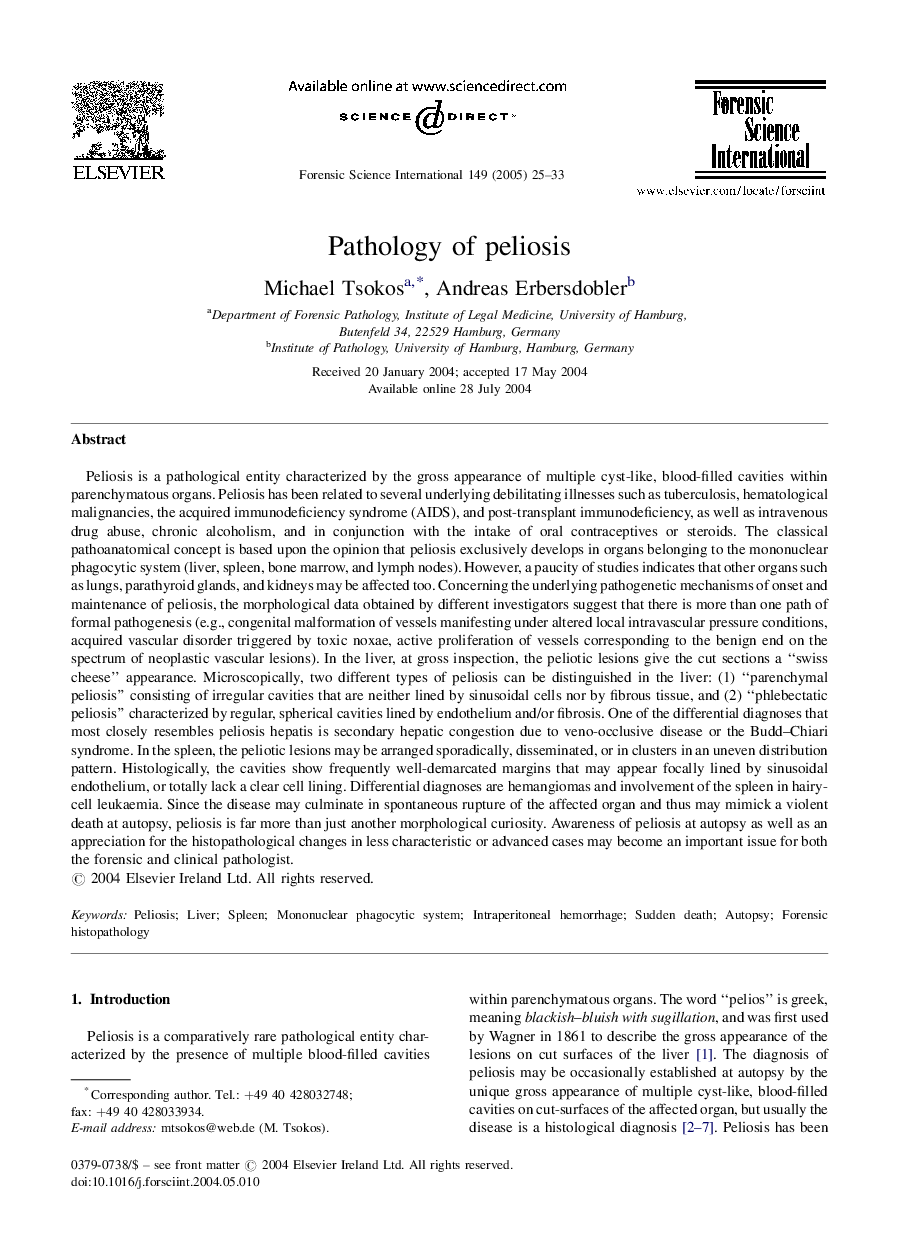| کد مقاله | کد نشریه | سال انتشار | مقاله انگلیسی | نسخه تمام متن |
|---|---|---|---|---|
| 10252660 | 160552 | 2005 | 9 صفحه PDF | دانلود رایگان |
عنوان انگلیسی مقاله ISI
Pathology of peliosis
دانلود مقاله + سفارش ترجمه
دانلود مقاله ISI انگلیسی
رایگان برای ایرانیان
کلمات کلیدی
موضوعات مرتبط
مهندسی و علوم پایه
شیمی
شیمی آنالیزی یا شیمی تجزیه
پیش نمایش صفحه اول مقاله

چکیده انگلیسی
Peliosis is a pathological entity characterized by the gross appearance of multiple cyst-like, blood-filled cavities within parenchymatous organs. Peliosis has been related to several underlying debilitating illnesses such as tuberculosis, hematological malignancies, the acquired immunodeficiency syndrome (AIDS), and post-transplant immunodeficiency, as well as intravenous drug abuse, chronic alcoholism, and in conjunction with the intake of oral contraceptives or steroids. The classical pathoanatomical concept is based upon the opinion that peliosis exclusively develops in organs belonging to the mononuclear phagocytic system (liver, spleen, bone marrow, and lymph nodes). However, a paucity of studies indicates that other organs such as lungs, parathyroid glands, and kidneys may be affected too. Concerning the underlying pathogenetic mechanisms of onset and maintenance of peliosis, the morphological data obtained by different investigators suggest that there is more than one path of formal pathogenesis (e.g., congenital malformation of vessels manifesting under altered local intravascular pressure conditions, acquired vascular disorder triggered by toxic noxae, active proliferation of vessels corresponding to the benign end on the spectrum of neoplastic vascular lesions). In the liver, at gross inspection, the peliotic lesions give the cut sections a “swiss cheese” appearance. Microscopically, two different types of peliosis can be distinguished in the liver: (1) “parenchymal peliosis” consisting of irregular cavities that are neither lined by sinusoidal cells nor by fibrous tissue, and (2) “phlebectatic peliosis” characterized by regular, spherical cavities lined by endothelium and/or fibrosis. One of the differential diagnoses that most closely resembles peliosis hepatis is secondary hepatic congestion due to veno-occlusive disease or the Budd-Chiari syndrome. In the spleen, the peliotic lesions may be arranged sporadically, disseminated, or in clusters in an uneven distribution pattern. Histologically, the cavities show frequently well-demarcated margins that may appear focally lined by sinusoidal endothelium, or totally lack a clear cell lining. Differential diagnoses are hemangiomas and involvement of the spleen in hairy-cell leukaemia. Since the disease may culminate in spontaneous rupture of the affected organ and thus may mimick a violent death at autopsy, peliosis is far more than just another morphological curiosity. Awareness of peliosis at autopsy as well as an appreciation for the histopathological changes in less characteristic or advanced cases may become an important issue for both the forensic and clinical pathologist.
ناشر
Database: Elsevier - ScienceDirect (ساینس دایرکت)
Journal: Forensic Science International - Volume 149, Issue 1, 20 April 2005, Pages 25-33
Journal: Forensic Science International - Volume 149, Issue 1, 20 April 2005, Pages 25-33
نویسندگان
Michael Tsokos, Andreas Erbersdobler,